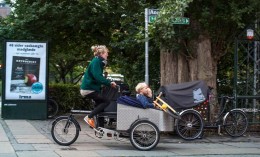Urban Design and Happy Cities

Is urban design really powerful enough to make or break happiness? The question deserves consideration, because the happy city message is taking root around the world. “The most dynamic economies of the 20th century produced the most miserable cities of all,” Peñalosa told me over the roar of traffic. “I’m talking about the U.S. Atlanta, Phoenix, Miami, cities totally dominated by cars.”
Charles Montgomery, the author of Happy City: Transforming Our Lives Through Urban Design, has an excerpt of his book in The Guardian, which argues that the happiest cities are the ones where people don’t have to drive as much. “Driving in traffic is harrowing for both brain and body,” Montgomery writes. “The blood of people who drive in cities is a stew of stress hormones. The worse the traffic, the more your system is flooded with adrenaline and cortisol, the fight-or-flight juices that, in the short-term, get your heart pumping faster, dilate your air passages and help sharpen your alertness, but in the long-term can make you ill.” Walkable, bike-able cities tend to make people happier because they’re also less socially isolating, Montgomery argues.
My subway line was having some trouble this morning, and we all tried to cram ourselves into crowded cars so we could make it to where we needed to be. “That’s what we get for voting for Bill de Blasio!” a man joked. Some of us laughed. Some of us remained agitated. It was certainly not socially isolating, but, squeezed against some strangers, I sort of wished I had a bike to hop on to ride downtown (there are no Citibikes in my neighborhood yet).
Photo: News Oresund
Support The Billfold
The Billfold continues to exist thanks to support from our readers. Help us continue to do our work by making a monthly pledge on Patreon or a one-time-only contribution through PayPal.
Comments